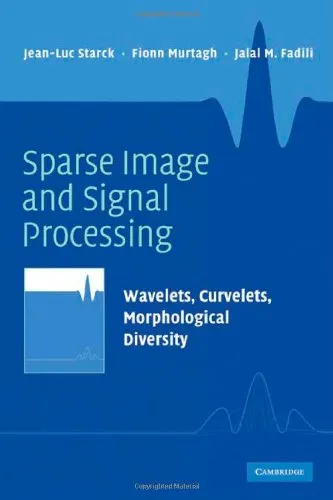Sparse image and signal processing: Wavelets, curvelets, morphological diversity
4.8
Reviews from our users

You Can Ask your questions from this book's AI after Login
Each download or ask from book AI costs 2 points. To earn more free points, please visit the Points Guide Page and complete some valuable actions.Introduction to Sparse Image and Signal Processing
Sparse Image and Signal Processing: Wavelets, Curvelets, Morphological Diversity explores the critical concepts and techniques that lie at the intersection of applied mathematics, computer science, and signal processing. This book provides a rich and systematic insight into sparse representations and their applications to imaging and signal analysis, making them accessible to both experts and newcomers to the field.
Sparse representations have become a cornerstone of modern image and signal processing, enabling advanced techniques for data compression, denoising, deblurring, and feature extraction among others. Building on theoretical foundations, this book delves into the real-world applicability of sparse methods, emphasizing tools such as wavelets, curvelets, and morphological diversity. Through a combination of mathematical rigor and practical examples, it equips readers with both the understanding and the tools to solve challenging problems in a wide array of disciplines.
Detailed Summary of the Book
The book begins by introducing the concept of sparsity in signal representation, explaining how sparse models can efficiently capture data's meaningful structures with minimal redundancy. The idea is simple yet profound: finding representations where most of the coefficients are zero or nearly zero allows for tremendous computational and memory advantages.
Key concepts covered in the book include wavelets and their multi-resolution analysis properties, curvelets which excel at representing edges and geometric data, and a diverse range of morphological methods. Each approach is meticulously explained, starting from first principles and building up to their implementation in processing tasks such as denoising, inpainting, and object detection.
The book further explores optimization techniques and algorithms, which are critical for solving sparse models effectively. Concepts like Lasso regression, basis pursuit, and compressed sensing are presented with practical examples and rigorous proofs. The mathematical content is complemented by step-by-step explanations that make complicated ideas accessible to a broad audience. Moreover, the book doesn’t shy away from discussing the limitations and potential pitfalls of sparse methods, offering a balanced perspective.
Key Takeaways
- Comprehensive understanding of the foundational concepts of spare representations.
- Insights into wavelets, curvelets, and morphological operators and how they differently address challenges in image and signal processing.
- Practical examples and case studies illustrating the power of sparse methods in real-world applications like image denoising, audio signal compression, and biomedical imaging.
- Introduction to modern optimization techniques essential for implementing sparse representations.
- Exploration of compressed sensing and its profound impact on undersampled data acquisition.
Famous Quotes from the Book
"Sparse representations open the doors to efficiency, transforming complex problems into manageable solutions by identifying the essentials and discarding the rest."
"Wavelets excel at simplicity in complexity, offering a lens to focus on what matters most in multi-scale data."
"Curvelets make geometry tangible, capturing the contours of a world full of edges and boundaries."
Why This Book Matters
The importance of Sparse Image and Signal Processing lies in its ability to address real-world challenges where data is voluminous, noisy, or incomplete. Sparse representations provide a toolkit to work smarter, not harder, by zeroing in on the most critical information. In an era where data science and machine learning dominate, this book equips readers to tackle complex problems with elegance and precision.
The text fills a significant gap by blending theoretical depth with practical insights. Engineers looking to design efficient systems, researchers exploring groundbreaking imaging techniques, or students embarking on a journey into signal processing will all find this book invaluable. Its applications span numerous fields, including medical imaging, astronomy, communications, and even finance.
Ultimately, the book demonstrates that sparse models are not just a computational trick but a way of thinking—extracting simplicity from complexity, order from chaos, and insight from data.
Free Direct Download
Get Free Access to Download this and other Thousands of Books (Join Now)
For read this book you need PDF Reader Software like Foxit Reader


